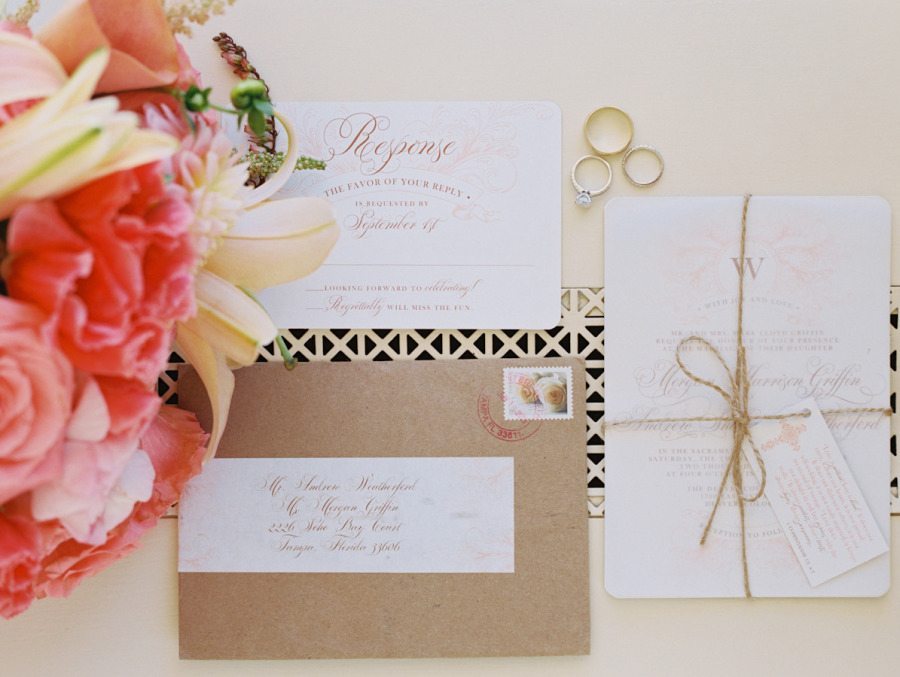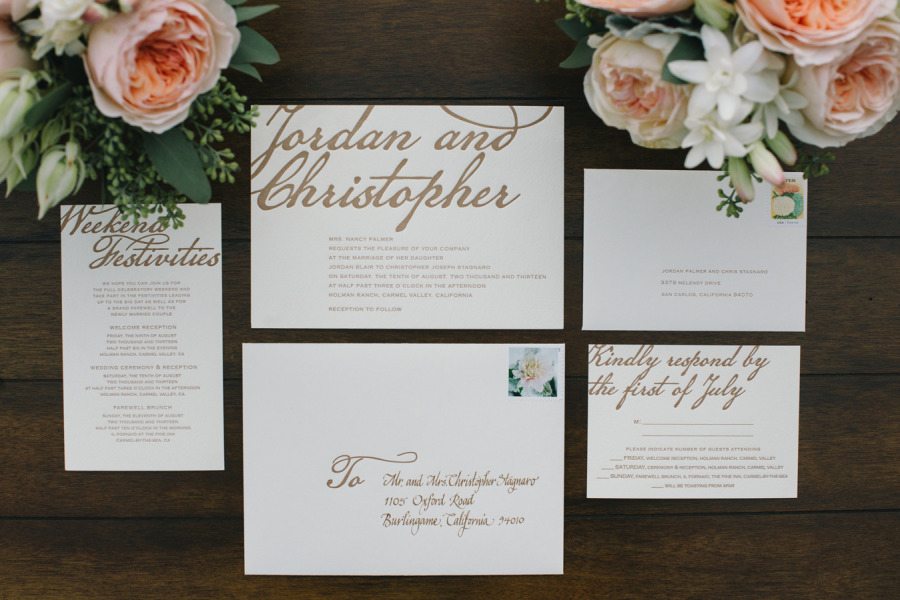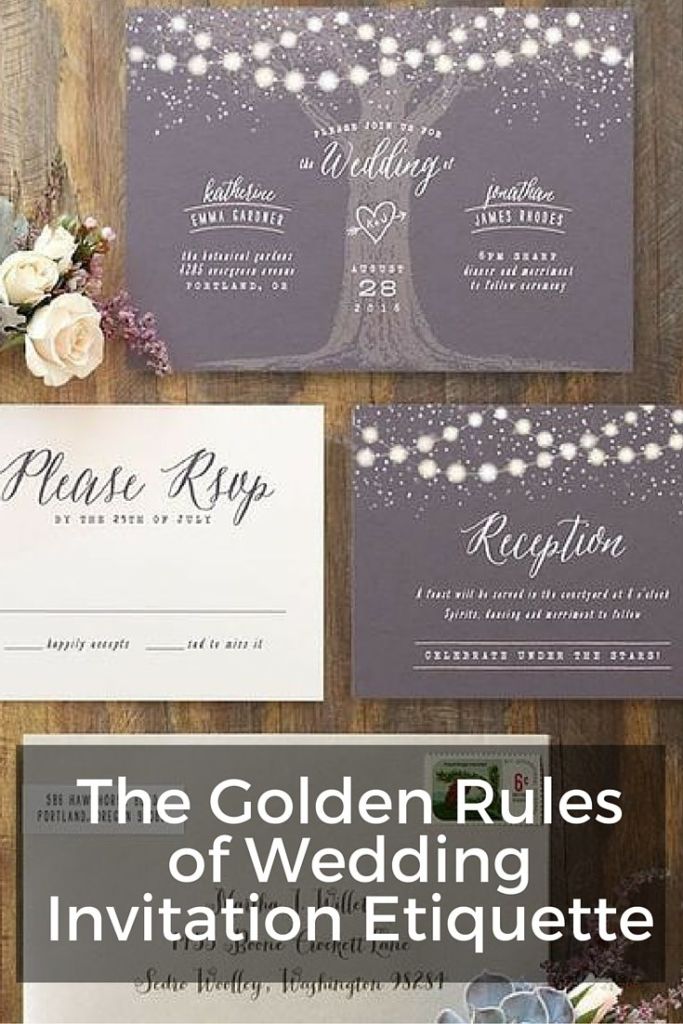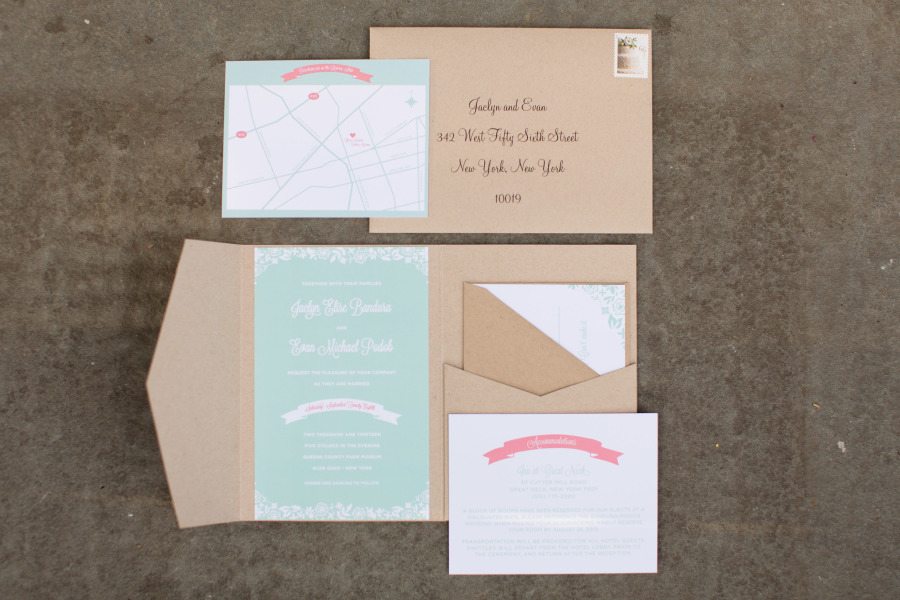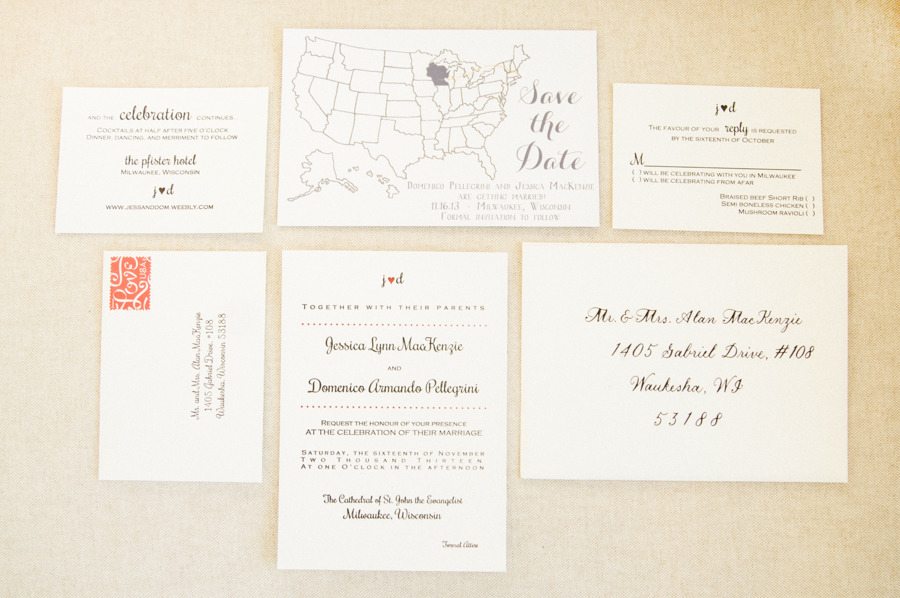The Golden Rules of Wedding Invitation Etiquette
A wedding invitation is much like any other invitation–it invites guests to an event. Like all invitations, it conveys information about the event, such as the who, what, when, where, and why. However, it is a rather unique type of invitation. This piece of paper can actually create an impression of glamour, good taste, wealth, warmth, or even, “OMG! Really? I can’t believe they thought that was appropriate!”
Don’t want that last reaction? Then simply follow the “Golden Rules”.
# 1 Follow flawless form. Hey, you’ve got style!
Remember that invitations convey information with more than just words. Formal or informal? The weight of the paper is heavier; the font is more ornate with formal weddings.
Never use labels to address your envelopes! But you’ve got bad handwriting? No problem. It’s okay to print envelopes with a high quality laser printer, using a handwriting font. For more formal weddings consider hiring a calligrapher.
What else makes an invitation formal? Wording. Use of the phrase, “request the honour of your presence” is common, even though this is typically reserved for religious ceremonies. Request the pleasure of your company is used for civil ceremonies, those not being held in a place of worship and for an invitation to the reception only.
With formal invitations, use the most formal format: listing parents as hosts. This doesn’t mean that the couple couldn’t use their names as hosts, especially if this is an encore wedding. And, if parents are divorced and remarried, the spouse should be listed. Steps are parents too.
# 2 Online is fine.
Invitations can be sent using any method, with the formality setting the method:
Formal = hand addressed and snail mail
Informal = fewer rules.
For the very informal wedding with few guests, it is perfectly appropriate to use the internet, i.e. “e-vites” (E-mail) or Facebook. But, be very careful to inform your guests of exactly who is and is not invited. Be specific.
# 3 Mention the players.
Traditionally, parents, especially the bride’s parents, invited (hosted) guests and were mentioned at the top of the wedding invitation. As mentioned before, this form is still used, especially for the most formal wedding. However, anyone can “invite” and appear as host. Anyone, except those who cannot host, like young children and those who are deceased (listed under the bride’s and groom’s names as: also the daughter/son of…, and on the wedding program.
# 4 No kiddie zone? Let them know.
Even on informal invitations, where there are fewer restrictions, never write “adult only” or “child free event”. It’s offensive to parents and sounds negative. So, how do you let these parents know this is a kid free event? Simple -just don’t include the children’s names on the inner envelope. What if there is no inner envelope? List those invited on the outer envelope. (If you ARE inviting children and there’s no inner envelope, only list the adults on the outer envelope and include an insert informing the couple that their children are also invited.) This is a clever way of also including a “plus-one”. But, be sure to get the full name of the guest/child and spell it out.
Mrs. Jane Jones and Guest = NO
Mrs. Jane Jones and Michael Gold = YES
This is especially important if you don’t want strangers attending. Use this same format for reception place cards too.
# 5 Invitations all around.
Anyone over the age of 16 to 18 (some differing opinions on age) receive their own invitation even if living in the same home. However, couples, even same gender, receive only one invitation. They are “invited” as a couple.
# 6 No B-listers please!
It’s a common problem. The couple wants everyone they know and love to come to their wedding, but their venue or budget won’t allow. Using an A and B list to solve the problem is tricky. No one wants to be a B-Lister. Ouch! If this must be done, timing is everything.
# 7 Don’t fish for gifts.
Some still believe and advise that all who receive a wedding invitation are obligated to send a gift. This belief tends to lead to invitations for everyone the parents and/or couple has ever known; especially those they know won’t attend. Honestly, those who receive these know they are being asked to send a gift but aren’t expected to attend. However, do send invitations to those you really want to attend. If you don’t think they can or will attend, send them any way. Sometimes people surprise us. And, those we love will know we aren’t just fishing for gifts.
# 8 Use enclosures.
Enclosures and response cards can be included with our invitations. Use enclosures to advise guests of attire (more on that later), inclusion of an escort or children, maps/directions, local activities, and an easy way to respond (response card). On the response card, there should be a clear RSVP date with address and/or phone number for replying, and include a stamp addressed envelope for ease of return. It’s fine to use an email address for the reply for an informal wedding.
Tip: take a completed invitation to the Post Office to be weighed. You will need to know how much postage costs per invitation AND how much postage your response cards require. It’s difficult enough to get these cards back on time, so make the process simple for the guest. Although, if not using response cards, guests would write formal replies and mail these on their dime…ah, dollar.
# 9 Dress for success!
Deciphering dress codes is getting more and more difficult as people create their own–Texas Formal?? So, when we advise our guests what to wear, it is best to stick to the tried and true dress codes, such as “formal” or ‘black tie’ and only for a formal, combination wedding/reception invitation.
So, what can we do to help our guests know what would be appropriate attire? After all, even if the wedding is informal, you probably don’t want guests arriving in swim suits. Including this information on an insert or enclosure should do the trick.
# 10 Resist to list… the registry.
Never ever include gift registry information with wedding invitations! Doing so makes the gift seem more important than the invitation. In fact, never print gift expectations on invitations, even if you don’t want any. And, requesting cash, in any manner, is viewed extremely negatively and greedy. Convey gift preference through word of mouth or on a wedding website, but never on the first page.
Do
- Begin to gather names and addresses of guests early in the wedding planning process.
- Include groom when creating and addressing invitations. And, allow plenty of time for this. It can be a very time consuming activity.
- For ease of assembly, lay all enclosures, envelopes, and tissue out for all invitations so you don’t forget anything.
- Mail invitations eight weeks before the wedding. Save the dates may be sent up to a year in advance. These are not invitations, but all who receive them also receive invitations.
- If not using an inner envelope, write all names of those invited on the outer envelope or list children and escorts on enclosures.
Do not
- Mention gift preferences, registry, gift table/card box/wishing well (gasp!) info on invitations–not even on enclosures.
- Invite guests you don’t want to attend just for a gift.
- List deceased parents or young children as hosts.
- Don’t use labels on envelopes.
- Use an A and B list if at all possible. If you do, do not send your B list out any later than 6 weeks before your event.
More Tips & Trips
Donna, Wedding Queen, President; Top Wedding Sites, Inc®, a wedding planning guide, and Recent Mother of the Groom
Formal Invitation Wording
Traditional style used when the bride’s parents are hosting:
*Dr. and Mrs. Richard I Kerr
request the honour of your presence (religious) or request thepleasure of your company (civil)
at the marriage of their daughter Susan Lynn Kerr to Mr. James Walker Crandall Saturday, the ninth of July
two thousand and twelve (optional)
at half past five in the evening
*Father of the bride is a doctor, so his title is used.
When the bride’s parents are hosting and the groom’s parents are included:
Mr. Richard Kerr and *The Honorable Jane Kerr
request the honour of your presence (religious)
or request thepleasure of your company (civil)
at the marriage of their daughter Susan Lynn Kerr
to Mr. James Walker Crandall
son of Mr. and Mrs. James Crandall
etc.
*Mother of the bride is a judge so she is listed on a separate line.
When both parents are hosting:
Mr. James Earle
and
*Captain Jane Earle
United States Navy
and
Mr. and Mrs. Michael Crandon
request the honour of your presence (religious)
or request thepleasure of your company (civil)
at the marriage of (their children)
Cheryl Lynn Earle
to
Mr. James Walker Crandon
etc. *Mother and father are listed on separate lines when one is an officer in the military. Branch of service is included
The bride or groom wish to honor a deceased parent:
*Mrs. Jane (or James) Earle
request the honour of your presence (religious)
or request thepleasure of your company (civil)
at the marriage of her daughter
Shannon Lynn Earle
also daughter of the late Mr. James Earle
to
Mr. James Walker Crandon
son of the late Mrs. Michelle (or Michael) Crandon
(or son of Mr. Michael Crandon and the late Mrs. Michelle Crandon)
etc. *It is becoming more common for women to use their first names rather than their husband’s.
When the bride’s stepfather is hosting along with the mother:
Mr. and Mrs. James Earle
request the honour of your presence (religious)
or
request thepleasure of your company (civil)
*at the marriage of her daughter Shannon Lynn Maurice to Mr. James Walker Crandon etc.
*If stepmother were hosting with father, “her” would be replaced with “his” daughter.
The couple is issuing the invitation, but honoring their parents:
Dr. Shannon Lynn Maurice
daughter of Mr. and Mrs. James Maurice
and
Mr. James Walker Crandon
son of Mr. and Mrs. Michael Crandon
request the honour of your presence (religious)
or request thepleasure of your company (civil)
etc.
Children hosting
Mr. and Mrs. James Louis Markum (the bride’s oldest son and spouse)
Ms. Shannon Lynn Markum (the bride’s younger daughter)
Mr. Samuel Graham Earle (the groom’s son)
request the honour of your presence (religious)
or request thepleasure of your company (civil) at the marriage of their parents Ms. Simone Clair Markum to Mr. Charles Sean Earle etc.
An invitation issued by the couple to the wedding and reception:
The pleasure of your company is requested
at the marriage of
Susan Lynn Kerr
and
Mr. James Walker Crandall Saturday, the tenth of May
at five o’clock
Happy Valley Resort
San Francisco And afterward at the reception
RSVP
Reception held in a different location than the wedding. The honour of your presence is requested at the marriage of
Susan Lynn Kerr
and
Mr. James Walker Crandall Saturday, the fifth of May
at five o’clock
Church of the Blessed Saints Sacramento
Please join us immediately afterwards for the reception
Granite Bay Country Club
4433 Granite Bay Drive
Granite Bay
RSVP
Informal Invitations
Options are limitless! Be creative and personal.
Parents Hosting
Jane and John Coates
along with Michelle and James Crandon
*invite you to the wedding of their children
Shannon Coates to James Crandon
Saturday, June 19, 2011 (year is optional)
at 6:00 in the evening (6 pm may be used)
LocationOptions: *invite you to share and celebrate (or share in the joy) at the marriage of their children; wish to share their joy in the wedding of their children…etc.
Most any phase can be used here as long as it “invites”.
The bride or groom wish to honor a deceased parent:
Maria Giordano
daughter of Mr. and Mrs. Frank Giordano
(or daughter of Mrs. Sharon Giordano and the late Mr. Frank Giordano)
and
James Smith
son of Mr. and Mrs. John Smith
(or son of Mr. John Smith and the late Mrs. Michelle Smith)
request the honour of your presence (religious)
or request thepleasure of your company (civil)
etc.
Couple Invites
Maria Giordano
and
James Smith
invite you to share their joy (most any phrase can used)
at their wedding
Etc.
This can also be a handwritten letter if your wedding is a small intimate event. Email is fine as well.
Children Hosting
Mary Ennis
with her daughter Lindsay Ennis
and Charles Earle
with his son Samuel Earle
wish to invite you to the celebration
of uniting these two families (most any phrase may be used here) etc.
Handwritten (or Email) Invitation
Dear John and Susan,
Michael and I will be married on July 9, at 2 pm at our home, with a cake and champagne reception following the ceremony. Please come and celebrate with us.
Warm regards,
***Be sure to spell out words like states, time and dates. For example; the fifteenth of June (not June 15th) and half after five o’clock in the evening, (not 5:30 pm).
Make sure to put return postage on all RSVP envelopes.
Always try to find out the names of a guest to avoid the impersonal “and guest” on invitations and place cards.
No punctuation is necessary when wording the invitation except abbreviations and a comma between city and state.
A folded formal wedding invitation is slid into the inner envelope, fold first and printed side facing up (in other words facing the opening of the envelope). Inserts go on to of the printed side.
@sealdwithappeal asked on Twitter:
What do you think about using “honor” vs. “honour” on wedding invitations ie: hono(u)r of your presence…
Answer: The words honour or favour, written in the British style, are traditional wording but honor and favor, in the American style, is appropriate too if the couple prefers.
In conclusion,
Send a wedding invitation to everyone you want to attend the wedding. Don’t try to guess whether or not they can travel. Go ahead and send the invite and let your guest decide. Often people will get their feelings hurt if they don’t receive an invitation – even if they know they can’t come. It’s nice to feel wanted. That said, never send an invitation to someone you haven’t had a relationship (and I don’t mean commenting on facebook photos!) with in years (Ex. college roommates, long lost cousins). That will appear as though you’re just looking to pad the guest list – either because you want more gifts or you have to fil a seating quota. If you are thinking about getting back in touch, the wedding isn’t the place to start.
photos via Style Me Pretty


